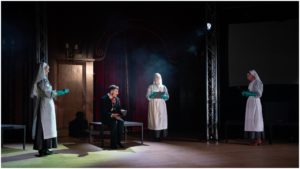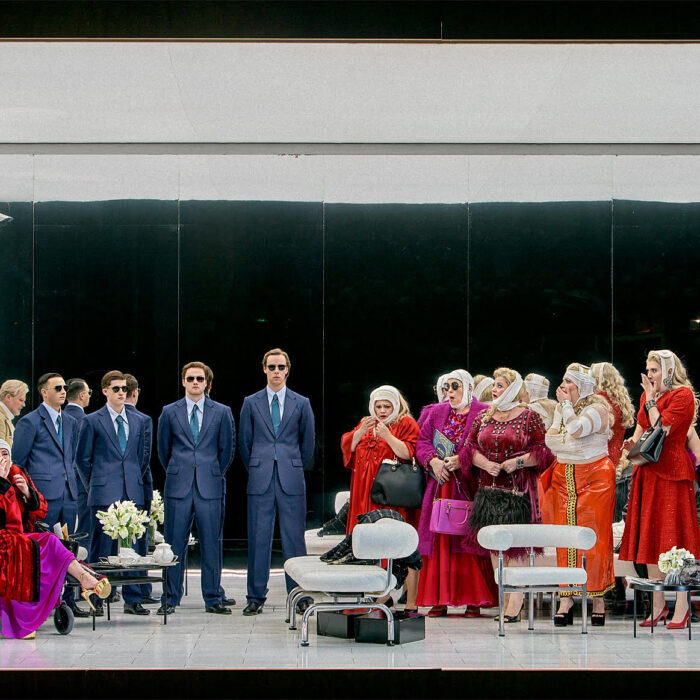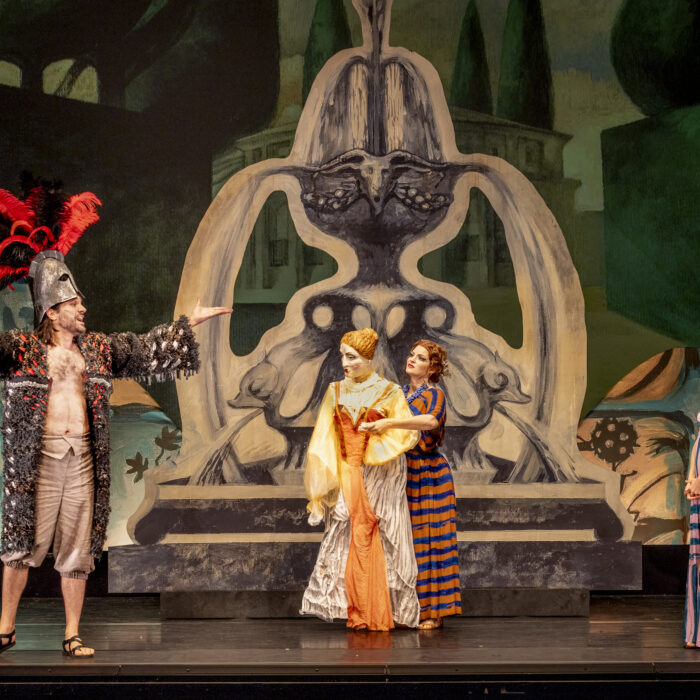
Gothic Opera 2021 Review: Bluebeard’s Castle
An Inventive & Challenging Reimagining of Bartók’s Operatic Masterwork
By Benjamin Poore(Credit: Nick Rutter)
Gothic Opera is one of the newest fringe opera companies to spring up in London. As the name suggests, they turn to works – generally treading lesser-known paths through the repertoire – that summon the uncanny, the ghoulish, and the frightening. Last week they made west London’s Porchester Hall their home for a new production of Béla Bartók’s one-act “Bluebeard’s Castle,” his one act adaptation of Charles Perrault’s eerie fairy tale, with a libretto by Béla Balázs.
The gothic is the ambivalent child of Enlightenment – a cultural and artistic space where lines between science and the occult and reason and madness blur. So too would skepticism towards the disenchanting potential of science and knowledge be a key plank of modernism across the arts, including for Bartók, whose fascination with folk music cast him as both anthropologist and shaman. These ideas shape Julia Mintzer’s imaginative revisionist staging of “Bluebeard’s Castle,” which contextualizes the story’s interest in confinement and power with the psychiatric institutions of the late nineteenth and early twentieth centuries.
This production picks up and extends two central planks of Bartók’s opera: the forbidding charisma of the titular patriarch, and the seclusion of the aristocratic stately home. Bluebeard is now a Svengali-ish “doctor” of the sort that headed Sanatoria and hospitals for those with “nervous conditions” of one kind or another, and whose treatments – early forms of ECT, hypnosis, hydrotherapies – ranged from the experimental to the occult (Bartók himself would die in just such an institution). These kinds of treatments ploughed a strange furrow in drawing on pseudosciences like mesmerism and vitalism, or even telepathy and the séance.
This setting also reminds us of the intimate violence embedded in the history of psychiatric treatment, much of it patriarchal in character, and the questions around authority and legitimacy attached to that particular profession. It is a hugely ambitious show in both technical and imaginative terms, with many distinctive and illuminating features. First of all is Mintzer’s reimagining of the central scenario. Judith exists in two forms in the show – as his “Deputy,” his most trusted assistant, sung as is usual, and as his “Patient,” danced in a central enclosed cell by Carmine de Amicis. He is attended by three Nurses (Alice Usher, Katherine MacRae, and Charlotte Osborn). They are all former patients of Bluebeard, whose voices occasionally double vocal lines or accentuate the orchestral texture.
In Mintzer’s production we watch the ritualistic treatment of the Patient unfurl, to calamitous consequence. The Patient submits wholly to the treatment, relinquishing his possessions in the opening dumb show. The treatment itself consists of an ECT-style glowing helmet that visualizes his innermost thoughts and fantasies. Each of the “doors” are those of perception, illuminated by animated projections created in collaboration with animators from Ravensbourne university. But the Patient ultimately sees through the spectacle and charade of his treatment to realize, ultimately, that Bluebeard is a charlatan. The spell of his authority is broken, and Bluebeard is left abandoned by his acolytes, including both Judiths.
The story for the most part is played out through dance and animation; for the much of the opera Judith and Bluebeard sing from the balcony, occluded and mysterious. It is powerfully and imaginatively lit by Will Alder, with great washes of red and purple manifesting something both sumptuous and threatening. As with any multimedia production where projections play a substantive role, there is the risk of an over-busy stage picture, but focusing the action on the central box of the Patient’s cell (as it were) meant it was contained and focused.
There were plenty of terrifying, atmospheric moments – the Patient wrapped in plastic, trapped in some kind of embryonic primordial envelope was skin-crawling. The only real technical problem in a show where surely many things can go awry was the supertitles, which were sometimes clouded by the lighting onstage, though perhaps this is less of a problem in an opera of such intense evocation and atmosphere. The most powerful animations were perhaps the hallucinogenic garden (Vincent Sautter and Tony Tyler) and Klaudia Grabczak’s armory. Charles Ogilvie’s set and costumes summon the weird rituals of this psychiatric vortex with deftness and flair.
“Bluebeard’s Castle” normally calls for a huge orchestra, armed to the teeth with percussion and especially lugubrious in its lowest reaches. Here Leon Saxby offered a new arrangement of the score, reducing the forces to four strings – courtesy of The Halcyon Quartet – and organ, played by Thomas Ang, all under the baton of Thomas Payne.
This is not so much a reduction but transformation of the score into a new entity, one which is compelling in its new context. The string quartet gives the score an intimate and especially expressionistic feel, sometimes evoking Bartók’s own great writing for that medium – it is by turns sinuous and mysterious, aided by Payne’s deft and careful handling of the score. The initial entry of the organ that fills out these textures had a slightly schlocky, Hammer Horror feel. But this quickly wore off as it boosted the small forces with a brooding background presence, and one very much of a piece with the prevailing mood. The balance between organ and strings was perfectly judged. The placing of the musicians, barely visible through the gloom, was atmospheric indeed, the music drifting across the hall with delicious mystery.
The leading roles are performed with plenty of panache, in a famously challenging score whose chromaticism and unusual leaps put special pressure on the leading roles. We don’t see much of Simon Wilding’s Bluebeard for the first portion of the show, though keeping he and Judith out of view allows the story downstairs to be told with more clarity. But what we hear is special indeed. Wilding has an unforced richness and darkness that sits perfectly in the role, capable of summoning velvety purr and magisterial command in equal measure, never turning metallic.
The Deputy Judith was sung with equal intelligence and control and Alexandra Long, whose voice had a steely quality that suggested a will to challenge and supplant Bluebeard. As the voice of the Patient, too, she excelled in moments of glittering enchantment and quiet mystery – the Treasure chamber proving a special highlight, as well as the terrifying stillness of the lake of tears. Carmine de Amicis danced and acted the role of the Patient – choreographed by himself, and assistant director on the show – with feverish intensity and emotional rawness, but never sliding into pantomime.
This is an inventive and challenging production of a too-little performed work, full of contemporary questions, and to boot one that refreshes and reimagines something essential about it.


